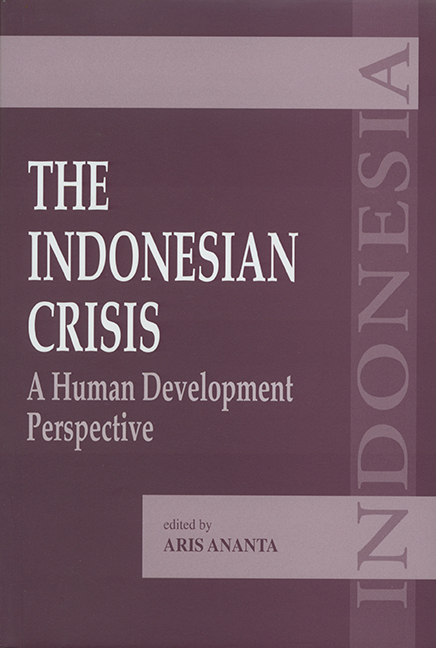Book contents
- Frontmatter
- Contents
- Acknowledgements
- List of Contributors
- Part I Introduction
- Part II Human Capital
- 5 Freedom from Fear: Social Disruption and System of Violence in Indonesia
- 6 Health Status of Indonesians During the Economic Crisis
- 7 The Indonesian Economic Crisis: Impacts on School Enrolment and Funding
- 8 Population Mobility and Social Conflict: The Aftermath of the Economic Crisis in Indonesia
- Part III Purchasing Power
- Part IV Emerging Issues
- Index
8 - Population Mobility and Social Conflict: The Aftermath of the Economic Crisis in Indonesia
from Part II - Human Capital
Published online by Cambridge University Press: 21 October 2015
- Frontmatter
- Contents
- Acknowledgements
- List of Contributors
- Part I Introduction
- Part II Human Capital
- 5 Freedom from Fear: Social Disruption and System of Violence in Indonesia
- 6 Health Status of Indonesians During the Economic Crisis
- 7 The Indonesian Economic Crisis: Impacts on School Enrolment and Funding
- 8 Population Mobility and Social Conflict: The Aftermath of the Economic Crisis in Indonesia
- Part III Purchasing Power
- Part IV Emerging Issues
- Index
Summary
Migration is a dream gone sour in Indonesia, with scenes of weary refugees dominating nightly news broadcast.
(Far Eastern Economic Review, 8 April 1999, p. 26)Introduction
An unprecedented reversed stream of population movement characterizes the pattern of Indonesia's demographic configuration today. Thousands of migrant families were forced to leave their homes as rampant conflict erupted in several provinces that were previously major destination areas of the state's transmigration policy. Social conflicts, among others, were manifested in the form of violence between migrants and the local population, apparently marking the shattering of the New Order's political order. Soeharto himself, the New Order's main pillar, was hesitantly pushed down, after more than three decades at the apex of power. The interconnection of population and conflict is not a new phenomenon, as Choucri (1984) has argued, “…conflict is a central feature of all political behavior, at all levels of human interaction, and the prominence of population variables in shaping political behavior places population issues and conflict in close proximity”. The incidence of social conflicts in Indonesia in 1999 and 2000 shows that, given the archipelagic nature of the country and its ethnic and religious plurality, the most serious population variable that has a strong link with social conflict has been geographical population mobility. As the conflict is often strongly loaded with an ethnic tone, the lack of information on the ethnic background of the migrants has resulted in difficulties for social demographers and social scientists in general to comprehend the conflict.
The demography of Indonesia has long been the object of the ruling élite's engineering schemes that have resulted in the establishment of current political-demographic construction. Besides its explicit social and economic objectives, strategic and political goals have always been at the centre of the state's demographic engineering practices. Populating the empty areas in the outer islands through colonial emigration policy and post-colonial transmigration policy has been a major demographic engineering initiative for almost a century. After independence, national integration was the ultimate goal perceived by the national leaders as the major justification to continue engineering the country's demographic configuration.
- Type
- Chapter
- Information
- The Indonesian CrisisA Human Development Perspective, pp. 213 - 244Publisher: ISEAS–Yusof Ishak InstitutePrint publication year: 2002



